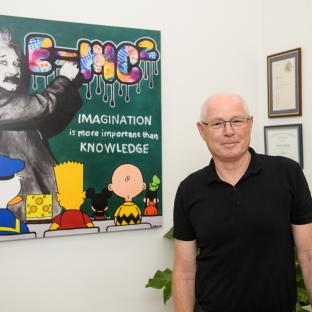

Prof. Yinon Rudich
Investigation of biological and toxicological effects of air pollution and Investigation of the atmospheric microbiome
Atmospheric particulate matter (PM) is an ensemble of solid or liquid aerosols containing a complex mixture of organic and inorganic compounds, mineral dust, sea salt, and water. The World Health Organization and the Global Burden of Disease Assessment state that exposure to ambient particulate pollution is the most important single global environmental health risk to people. PM is therefore regulated in most developed countries on a total mass concentration basis, but the exact constituents of PM that lead to adverse health effects and the underlying biological mechanisms by which they induce these effects are not known. Identifying these constituents and mechanisms remains an outstanding challenge. Pollution particles are emitted or formed from many man-made and natural sources, and undergo extensive chemical transformation through oxidation reactions in the atmosphere, resulting in thousands of different chemical species that can induce a range of biological responses upon exposure. The chemical diversity together with the diversity of the biological outcomes limits the ability to establish a mechanistic link between chemical composition and the health effects they cause.
The target of this project focuses on the investigation of the mechanisms (biological and toxicological effects) induced by different types of aerosol (Particulate matter, secondary organic aerosols (SOA), biomass burning, and dust) with advanced exposure models. In vitro exposure will focus on optimizing exposure of human epithelial lung cells and other tissue (liver, fat) cultures and the development of differentiated 3D cell cultures and disease-oriented tissue models for ALI exposures to represent the lung. In addition individual in vivo exposure models will be used in order to validate the cell line/tissue model results and for investigating the systemic effects of exposure.
- Establishing a 3D cell culture representing the lung for exposure in the ALI exposure system.
- Hands-on molecular biology methods bioinformatics and deep sequencing analysis (microarray, proteomics etc.)
- Correlation of toxicological responses with the various components of particulate matter.
Our group takes part in the international Helmholtz lab that offers a dynamic and international collaboration between the Weizmann Institute of Science, Helmholtz centers in Julich and Munich, and the University of Rostock. The work involves active collaborations between the participating groups and taking active roles in joint experimental campaigns, data analyses, paper writing, and weekly joint seminars among other activities.
Investigation of the atmospheric microbiome
Additional activities in the lab include studying the microbiome of the atmosphere. Dust storms transfer bacteria and fungi from remote places over thousands of kilometers. The frequency and severity of dust storms are projected to increase under global warming scenarios. We study the population of these microorganisms looking into their function potential and looking for transport of pathogens that can affect agriculture and human health. The work includes sampling of atmospheric samples, sequencing of DNA and RNA and conducting bioinformatics analyses of the results.

